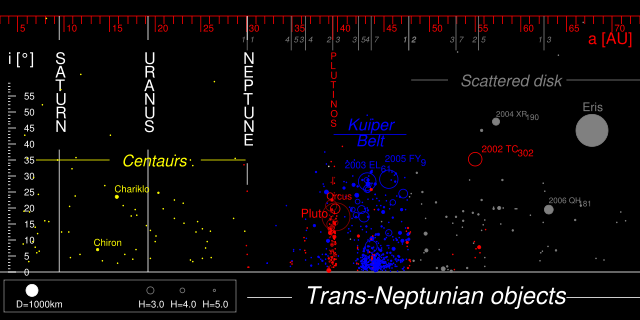From Wikipedia, the free encyclopedia
 |
This is a file from the Wikimedia Commons. The description on its description page there is shown below.Commons is a freely licensed media file repository. You can help.
|
Summary in English
The distribution and classification of the trans-Neptunian Objects. Generated by a program written by Eurocommuter.
Main graph
The characteristics of an object in the graph represent:
- Distance along horizontal axis - the object's orbital semi-major axis a in Astronomical Units
- Distance along vertical axis - the object's orbital inclination i in degrees
- Size of the circle - the object’s size relative to others:
- for a few large objects, the diameter drawn represents the best current estimates
- for all the others, the diameter of the circle represents the absolute magnitude H of the object.
- vertical bars mark orbital resonances with Neptune; 1:1 marks the position of Neptune’s orbit (and its Trojan asteroids), 2:3 marks the orbit of Pluto and plutinos.
Families
██ Cubewanos
██ Centaurs (not formally members of Trans-Neptunian objects, shown for reference only)
██ Resonant objects - Plutinos and Resonant trans-Neptunian objects
██ Scattered disc objects
To highlight other resonant objects, all of them are plotted in red.
Data source
Minor Planet Centre Orbit database (MPCORB) as of 2007-12-01. Resonant orbits' classification from MPC Circular 2007-W54 (2007-11-22). Diameter estimates include Stansberry et al (Spitzer). See refs in the related articles.
Description en français
La distribution et les familles des transneptuniens Graphique généré par un programme écrit par Eurocommuter.
Graphe principal
La position d’un objet représente
- le demi axe majeur (rayon moyen) de son orbite a en in au (l’axe horizontal)
- l’inclination de son orbite i en degrés (axe vertical).
Le diamètre du cercle montre la taille relative de l’objet aux autres. Pour quelques grands objets, le diamètre représente la meilleure estimation connue. Pour tous les autres, le diamètre du cercle représente la magnitude absolue de l’objet.
Les positions des résonances avec Neptune sont marqués par des traits verticaux; 1:1 marque la position de l’orbite de Neptune (et ses Troyens), 2:3 marque l’orbite de Pluton (et ses lunes) etc.
Familles
- Centaures ne sont pas formellement membres des transneptuniens
- La Ceinture de Kuiper regroupe
- Objets classiques, cubewanos, en bleu
- Objets résonants en 2:3 et 1:2, en rouge
- Objets épars, en gris
Pour repérage facile tous les autres objets résonants sont en rouge.
Source des données
Base de données MPCORB au 1er decembre 2007, sauf pour la classification des orbites résonantes où le Minor Planet Circular 2007-W54 a été utilisé.
Licensing
I, the copyright holder of this work, hereby publish it under the following licenses:
 |
Permission is granted to copy, distribute and/or modify this document under the terms of the GNU Free Documentation license, Version 1.2 or any later version published by the Free Software Foundation; with no Invariant Sections, no Front-Cover Texts, and no Back-Cover Texts. A copy of the license is included in the section entitled " GNU Free Documentation license".
Aragonés | العربية | Asturianu | Беларуская (тарашкевіца) | Български | বাংলা | ইমার ঠার/বিষ্ণুপ্রিয়া মণিপুরী | Brezhoneg | Bosanski | Català | Cebuano | Česky | Dansk | Deutsch | Ελληνικά | English | Esperanto | Español | Eesti | Euskara | فارسی | Suomi | Français | Gaeilge | Galego | עברית | Hrvatski | Magyar | Bahasa Indonesia | Ido | Íslenska | Italiano | 日本語 | ქართული | ភាសាខ្មែរ | 한국어 | Kurdî / كوردی | Latina | Lëtzebuergesch | Lietuvių | Bahasa Melayu | Nnapulitano | Nederlands | Norsk (nynorsk) | Norsk (bokmål) | Occitan | Polski | Português | Română | Русский | Slovenčina | Slovenščina | Shqip | Српски / Srpski | Svenska | తెలుగు | ไทย | Tagalog | Türkçe | Українська | اردو | Tiếng Việt | Volapük | Yorùbá | 中文(简体) | 中文(繁體) | +/- |
You may select the license of your choice.
|
File history
Click on a date/time to view the file as it appeared at that time.
|
|
Date/Time |
Dimensions |
User |
Comment |
| current |
16:26, 26 March 2008 |
2,000×1,000 (118 KB) |
Chesnok |
|
|
|
15:40, 2 December 2007 |
2,000×1,000 (118 KB) |
Eurocommuter |
|
|
|
15:34, 2 December 2007 |
2,000×1,000 (118 KB) |
Eurocommuter |
|
|
|
08:21, 9 March 2007 |
2,000×1,000 (114 KB) |
Eurocommuter |
|
|
|
00:37, 18 November 2006 |
2,000×1,000 (121 KB) |
Augiasstallputzer |
|
|
|
08:44, 14 September 2006 |
800×400 (121 KB) |
Eurocommuter |
|
|
|
10:00, 5 April 2006 |
800×400 (122 KB) |
Eurocommuter |
|
|
|
01:17, 23 February 2006 |
800×400 (121 KB) |
Eurocommuter |
|
File links
The following pages on Schools Wikipedia link to this image (list may be incomplete):

